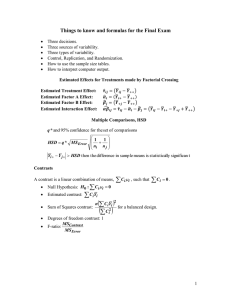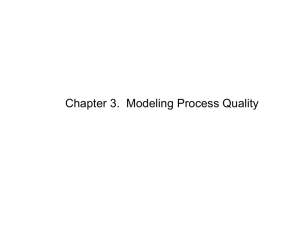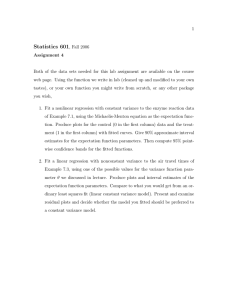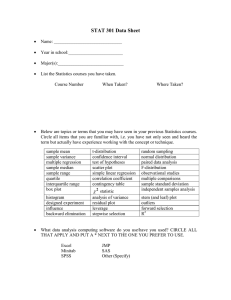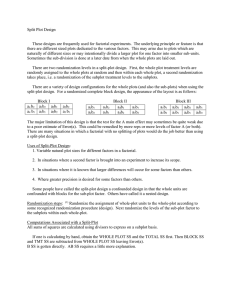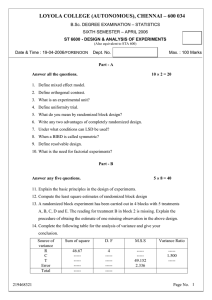Stat 402 B – Final Exam Take-home Problems
advertisement
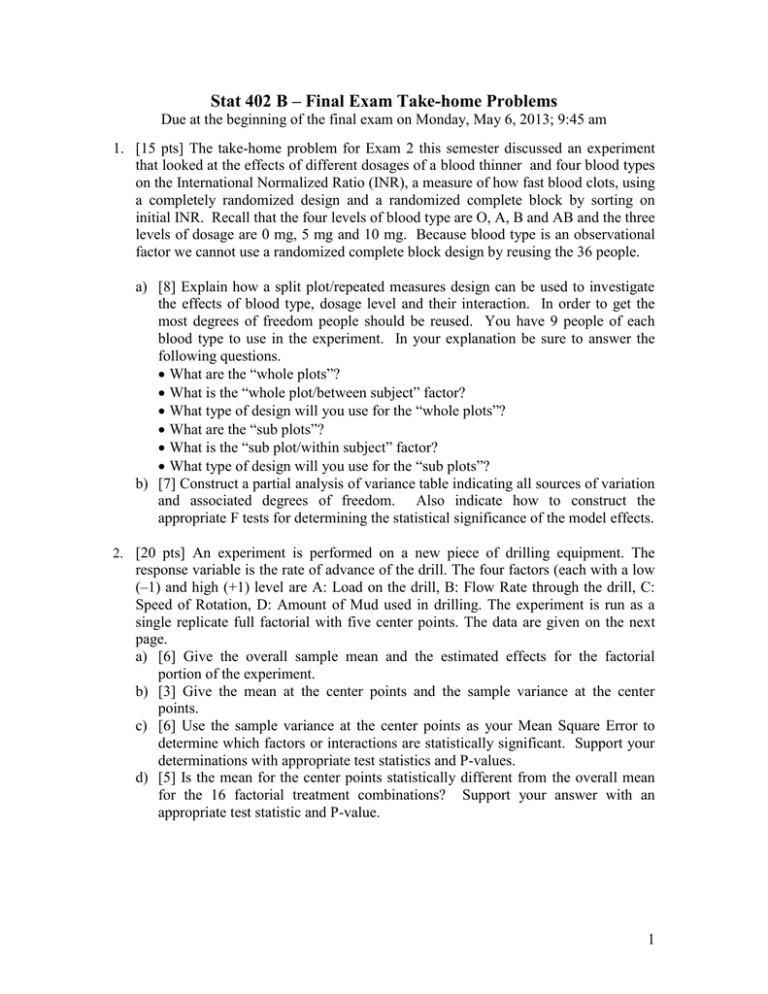
Stat 402 B – Final Exam Take-home Problems Due at the beginning of the final exam on Monday, May 6, 2013; 9:45 am 1. [15 pts] The take-home problem for Exam 2 this semester discussed an experiment that looked at the effects of different dosages of a blood thinner and four blood types on the International Normalized Ratio (INR), a measure of how fast blood clots, using a completely randomized design and a randomized complete block by sorting on initial INR. Recall that the four levels of blood type are O, A, B and AB and the three levels of dosage are 0 mg, 5 mg and 10 mg. Because blood type is an observational factor we cannot use a randomized complete block design by reusing the 36 people. a) [8] Explain how a split plot/repeated measures design can be used to investigate the effects of blood type, dosage level and their interaction. In order to get the most degrees of freedom people should be reused. You have 9 people of each blood type to use in the experiment. In your explanation be sure to answer the following questions. What are the “whole plots”? What is the “whole plot/between subject” factor? What type of design will you use for the “whole plots”? What are the “sub plots”? What is the “sub plot/within subject” factor? What type of design will you use for the “sub plots”? b) [7] Construct a partial analysis of variance table indicating all sources of variation and associated degrees of freedom. Also indicate how to construct the appropriate F tests for determining the statistical significance of the model effects. 2. [20 pts] An experiment is performed on a new piece of drilling equipment. The response variable is the rate of advance of the drill. The four factors (each with a low (–1) and high (+1) level are A: Load on the drill, B: Flow Rate through the drill, C: Speed of Rotation, D: Amount of Mud used in drilling. The experiment is run as a single replicate full factorial with five center points. The data are given on the next page. a) [6] Give the overall sample mean and the estimated effects for the factorial portion of the experiment. b) [3] Give the mean at the center points and the sample variance at the center points. c) [6] Use the sample variance at the center points as your Mean Square Error to determine which factors or interactions are statistically significant. Support your determinations with appropriate test statistics and P-values. d) [5] Is the mean for the center points statistically different from the overall mean for the 16 factorial treatment combinations? Support your answer with an appropriate test statistic and P-value. 1 Trmt. Comb. 1 a b ab c ac bc abc d ad bd abd cd acd bcd abcd Center Center Center Center Center A –1 +1 –1 +1 –1 +1 –1 +1 –1 +1 –1 +1 –1 +1 –1 +1 0 0 0 0 0 B –1 –1 +1 +1 –1 –1 +1 +1 –1 –1 +1 +1 –1 –1 +1 +1 0 0 0 0 0 C –1 –1 –1 –1 +1 +1 +1 +1 –1 –1 –1 –1 +1 +1 +1 +1 0 0 0 0 0 D –1 –1 –1 –1 –1 –1 –1 –1 +1 +1 +1 +1 +1 +1 +1 +1 0 0 0 0 0 Rate 1.68 1.98 3.28 3.44 4.98 5.70 9.93 9.07 2.07 2.44 4.09 4.53 7.77 8.43 11.75 12.30 4.54 5.18 5.53 4.49 5.01 2



